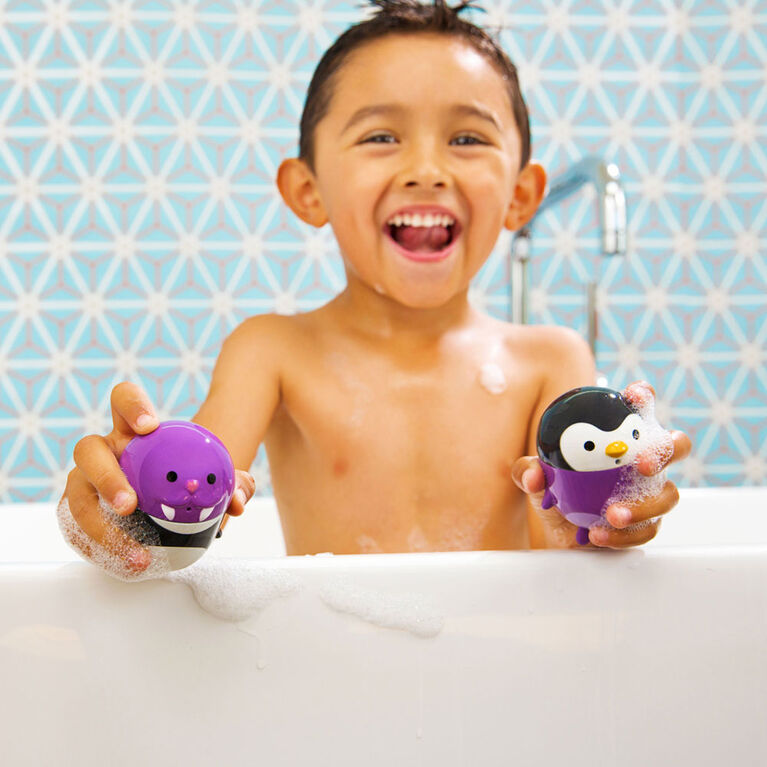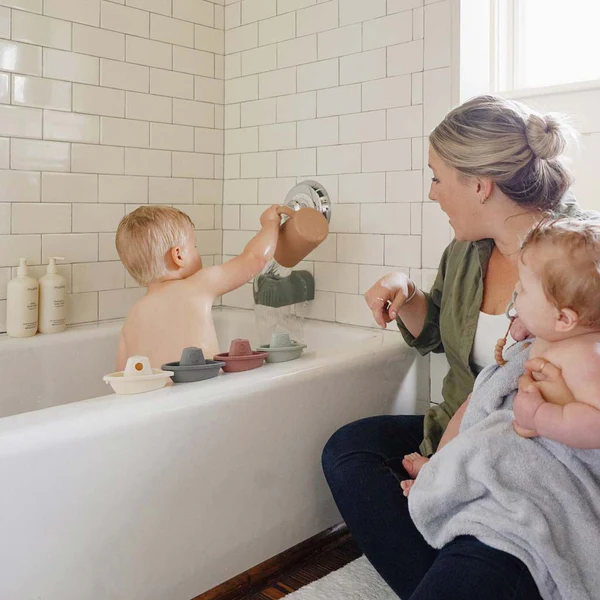The Importance of Mold-Free Bath Toys
Ensuring that kids’ bath toys are free from mold is crucial for their health. Mold can cause various health issues, from mild allergic reactions to more serious respiratory problems. Children, especially those who are young or have immune deficiencies, are more at risk. Mold in bath toys isn’t just a cleanliness concern—it’s a health priority. Bath toys that don’t mold prevent these risks and help maintain a safe play environment. Parents need to be vigilant about choosing bath toys that are less likely to harbor mold.
Frequent exposure to moldy toys can sensitise children to mold spores, leading to allergies or asthma. Mold grows in damp and warm environments, making the bathroom an ideal breeding ground. Bath toys that trap water and are difficult to clean are particularly susceptible. Parents should prioritize bath toys that don’t mold to minimize these dangers. Mold-free toys also tend to last longer, so they’re a good investment for parents looking for durable play options.
Identifying Bath Toys Prone to Mold
Knowing which bath toys are prone to mold helps prevent health hazards. To identify these toys, look for common features that contribute to mold growth. First, toys with hard-to-reach crevices often trap water and become mold hotspots. Squeeze toys fall into this category. When squeezed, they intake bathwater, and if not dried properly, the lingering moisture fosters mold. Toys made from porous materials like foam also absorb water, making them hard to dry and prone to mold growth.
Also, look at the toy’s design. Complex shapes with multiple parts can create hidden damp areas. These spots are difficult to clean and dry. Bath toys without proper ventilation or drain holes retain moisture too. In addition, toys that are not specifically designed for bath use can quickly become moldy if left in a wet bathroom. Such toys might include non-waterproof dolls or fabric toys.
As a rule of thumb, the more cavities and absorbent surfaces a toy has, the higher the potential for mold development. Opting for bath toys that don’t mold can significantly reduce the risk and contribute to a safer bath environment for children. When shopping, it is crucial to be informed and vigilant about selecting toys that are less susceptible to mold, ensuring durable and healthy playtime.
Materials to Look for in Mold-Resistant Bath Toys
Choosing the right materials is key for bath toys that don’t mold. Parents searching for long-lasting and safe options for bath time need to consider a few specific materials known for their mold-resistant properties.
First, look for bath toys made of solid rubber or silicone. These materials do not have pores that hold water, making them easier to clean and dry, and therefore less likely to harbor mold spores. Moreover, silicone bath toys can often withstand high temperatures, which means they can be sterilized to kill any germs or mold.
Second, plastic toys that come apart for cleaning can be an excellent choice. These allow all surfaces to be exposed to air, ensuring thorough drying and minimizing mold risk. Just be sure they are also BPA-free and non-toxic, as safety is paramount.
Lastly, toys with a one-piece design eliminate joints where water might collect. One-piece toys have no crevices for mold to grow and are simplest to keep clean. Bath toys with fewer details and simple shapes are less prone to mold and are easier for children to hold and play with.
In summary, mold-resistant bath toys tend to be made of smooth, non-porous materials like rubber or silicone, are easy to clean, and have simple, one-piece designs. Keep these criteria in mind when selecting new toys for a mold-free and healthy bathtime experience.
Top Picks for Mold-Free Bath Toys
When choosing bath toys that don’t mold, specific products stand out. These top picks provide fun and safety during bath time. Remember, materials like non-porous rubber and silicone are best for mold resistance.
Textured Rubber Ducks – Classic rubber ducks with a twist. They have no holes and a textured surface, making them easy to clean and unlikely to harbor mold.
Silicone Shapes and Animals – Bath toys come in food-grade silicone shapes and animals. They are soft, durable, and boilable to kill germs.
Floating Plastic Books – These are waterproof and simple to wipe down. They add an educational touch to bath time without the risk of growing mold.
Stackable Cups – Plastic cups made without nooks or crannies prevent water from getting trapped. Kids can pour, stack, and learn while they bathe.
One-Piece Bath Squirters – Unlike traditional squirt toys, one-piece designs won’t suck up water. This means no internal moisture and no mold.
Each of these options has a unique appeal and mold-resistant quality. They meet the criteria of being easy to clean and dry, simple in design, and safe for little ones. Consider these picks to ensure your child’s bath time is both engaging and mold-free.
Tips for Maintaining Mold-Free Bath Toys
Maintaining bath toys that don’t mold is key for children’s health. Here are tips to help keep bath toys in shape:
- Dry Toys Thoroughly: After bath time, rinse toys with clean water. Shake out excess moisture. Let toys air dry completely before storing.
- Regular Cleaning: Clean bath toys regularly with a vinegar solution or mild soap. This helps prevent mold growth.
- Adequate Storage: Store bath toys in a dry, well-ventilated area. Avoid leaving them in the tub.
- Sun Exposure: Let toys bask in sunlight occasionally. Sunlight can naturally kill mold spores.
- Rotate Toys: Don’t use the same toys every day. Rotate them to give time for each toy to dry fully.
- Close Supervision: Watch for water entering toys. Squeeze out water if you find any inside.
- Avoid Hard-to-Clean Toys: Choose toys with simple designs. They are easier to keep mold-free.
Following these tips can make bath toys last longer and stay safe for kids to enjoy. Replace any toys that do show signs of mold immediately for your child’s safety.
When to Replace Bath Toys and Signs of Mold
Recognizing when to replace bath toys is crucial for preventing mold exposure. Vigilance is key. Parents should inspect toys regularly for any signs of mold, which typically appears as black, green, or red spots. If you see these signs, it’s time to dispose of the toy. Another clear indicator is a musty odor, which suggests that mold or bacteria may have colonized the toy.
Toys made of fabric or foam are especially prone to mold. Replace these often. Hard plastic or rubber toys may last longer, but inspect them for cracks or damage. Water can seep into damaged areas and create a mold haven. Even if there are no visible signs of mold, it’s a good practice to replace bath toys periodically. After a few months of regular use, consider refreshing your child’s toy collection.
Safety always comes first. With bath toys that don’t mold, children can enjoy a fun and healthy bathtime routine without the risks associated with mold exposure. Keeping an eye out for signs of mold and knowing when to replace toys can help maintain this safe environment.
The Impact of Mold on Children’s Health
Mold poses significant health risks to children during their bathtime adventures. Children’s immune systems are still developing, making them more vulnerable to the harmful effects of mold exposure. Mold can cause a variety of health issues, primarily impacting respiratory health. Children exposed to mold may develop allergies, asthma, or other breathing difficulties.
Additionally, mold exposure can lead to more frequent and severe respiratory infections. Children with mold sensitivities can experience symptoms like coughing, wheezing, and a stuffy nose. For those with asthma, the presence of mold can trigger attacks, worsening their condition.
Long-term exposure to mold is especially concerning. It can contribute to chronic health problems that may affect children into adulthood. Simply put, bathtime should be safe and enjoyable, not a source of health problems. Thus, choosing bath toys that don’t mold is crucial for protecting kids’ health and ensuring a joyful bathtime routine.
Alternatives to Traditional Bath Toys for a Safer Bathtime
Looking beyond traditional options, there are innovative bath toys that don’t mold. These alternatives promise a safer, healthier bathtime experience.
Foam Letters and Numbers: Unlike typical foam toys, these come with no backings to trap water. They stick to tub walls and are easy to clean.
Silicone Bowls and Cups: These multi-use items can double as bath toys. They are non-porous, easy to sterilize, and come in many colors.
Bath Crayons and Paints: Look for water-soluble, mold-resistant varieties. Kids can harness their creativity without the risk of mold.
Plastic Mesh Bags: Rather than toys, use these bags to store other bath items. They drain water away, ensuring toys dry completely.
Washcloths and Sponges: Special antibacterial options are available. They can be used for washing and playing while resisting mold growth.
By exploring these alternatives, parents can keep their children’s bath time mold-free and full of imagination. With the right care and selection, the fun never stops, and the health risks are minimized.



